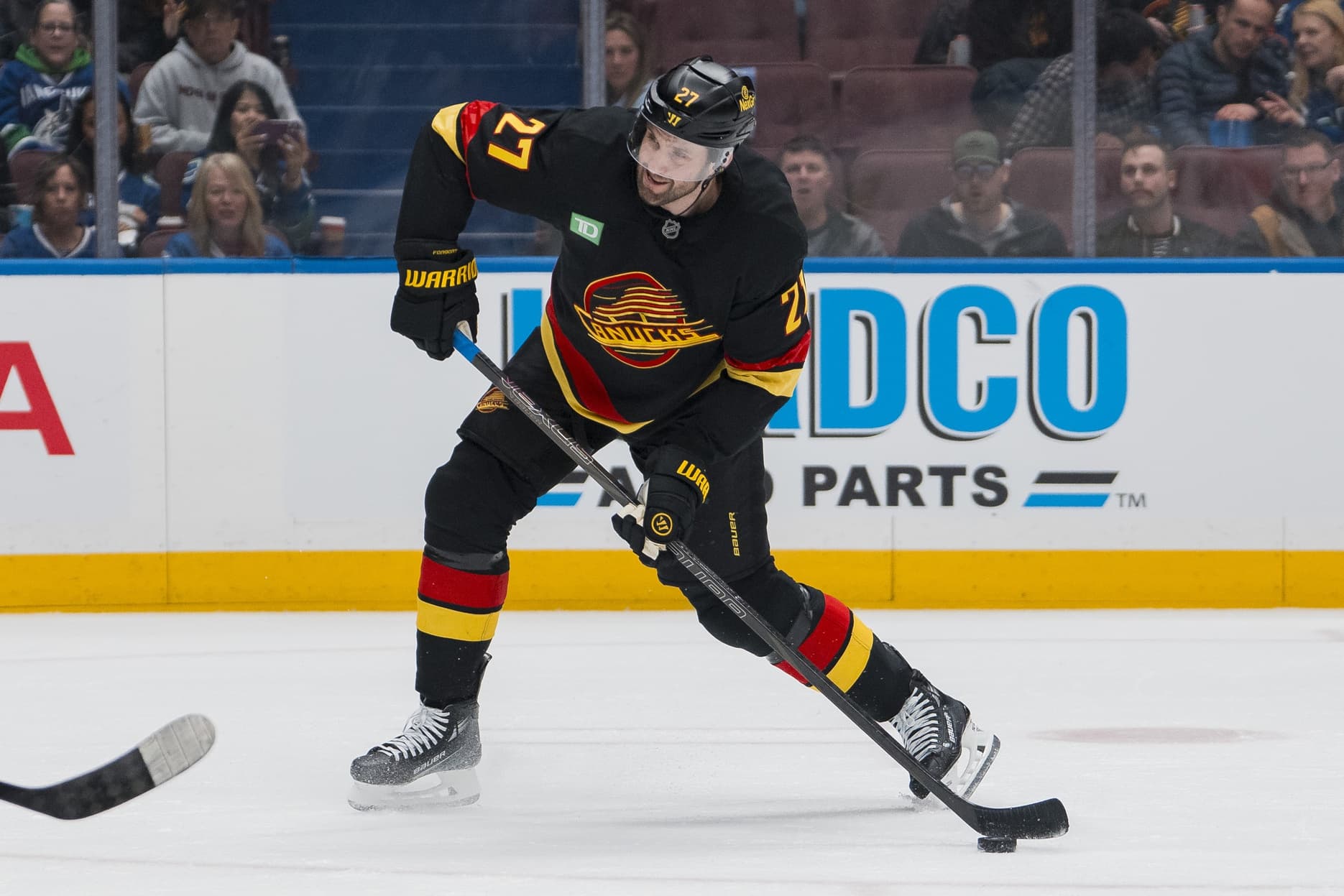Nation Sites
The Nation Network
CanucksArmy has no direct affiliation to the Vancouver Canucks, Canucks Sports & Entertainment, NHL, or NHLPA
The Derek Forbort extension works quite well with the Canucks’ blueline plans for 2025/26

Photo credit: © Bob Frid-Imagn Images
Jun 4, 2025, 12:15 EDTUpdated: Jun 4, 2025, 12:14 EDT
The first domino of the 2025 offseason has fallen, and it’s a move that many predicted at the end of the 2024/25 campaign. The Vancouver Canucks announced on Tuesday that Derek Forbort had signed a one-year, $2 million extension which will keep the 33-year-old defender in the fold for at least another season.
On the surface of it, it’s hard to argue that Forbort didn’t deserve another year, at the very least. After a slow start to his Canucks tenure – one that may have been brought on by consistently being paired with Vincent Desharnais in the early going – Forbort found his feet in Vancouver and proved of immense value. He deserves a lot of the credit for the Canucks’ midseason penalty-killing turnaround, and by some measures was one of the best individual PKers in the entire league in 2024/25.
Forbort was also one of the only Canucks to stick up for teammates on a nightly basis last year, which led to his season ending early thanks to a sucker-shot from Yakov Trenin that busted Forbort’s orbital bone.
Put it all together, and few could be upset that Forbort is getting another year, nor with the price-tag, which is only a slight raise on the $1.5 million Forbort made previously.
And yet, there is at least some worry around that Forbort’s extensions signals that the Canucks aren’t fully committed to their youth movement on the blueline.
Heading into 2025/26, the Canucks have a well-established and defined top-four of Quinn Hughes, Filip Hronek, Marcus Pettersson, and Tyler Myers.
Behind that quartet, it was expected that the younger Elias Pettersson – who practically blew the doors down this past season and forced his way into a permanent roster spot – would form one half of the bottom pairing, alongside either Tom Willander or Victor Mancini. Not only does this set of three make up a high-quality lower-end, they also represent the future of the Vancouver blueline.
It was always expected that the Canucks would sign at least one veteran defender to serve as a fill-in or extra. But Forbort’s role and importance on last year’s team, combined with his salary of $2 million, give him the appearance of being far more than the average ‘7D.’
In short, the ‘worry’ – if that’s not too dramatic of a term here – is that Forbort’s re-signing will mean fewer minutes in 2025/26 for any or all of Pettersson, Willander, or Mancini.
But that’s not necessarily the case.
Even last season, once Pettersson had established himself with the team, he rarely sat in favour of Forbort, or even missed out on many minutes. So long as he doesn’t fall victim to a performance-reducing sophomore slump, it stands to reason that EP25 is in no danger of losing his spot on the depth chart.
So, already on the left side, we’ve got a hierarchy of Hughes, Pettersson, Pettersson, and Forbort fits in neatly enough after that.
Now, in 2024/25, much of the final stretch run featured both Pettersson and Forbort in the lineup, with both taking turns on the right side, but Forbort doing so more frequently. It stands to reason, the, that Forbort could feasibly knock Willander and/or Mancini out of the lineup. This is potentially the biggest stressor to roster-predicting fans, who already had some notion that there wouldn’t be room for both Willander and Mancini, meaning they’d have to alternate time spent in the press box or Abbotsford.
And, sure, that will probably happen from time to time. But probably not so frequently as to constitute any sort of real problem. One of Willander or Mancini will almost certainly crack the opening day roster, and the Canucks are not so foolish as to keep a young RD with high potential in the pressbox all year. When in Vancouver, they’ll get their chances to play, and when they’re not getting their chances to play, they’ll likely be in Abbotsford.
Here, Forbort’s ability to play either side isn’t a hindrance at all. It’s actually a direct positive, and one that will allow Adam Foote and Co. to insert him all over the blueline as they see fit. Versatility is a great thing when it comes to being an extra D. When healthy, it should allow him to rotate through and give occasional breaks to EP25, Willander, and Mancini, without taking so much time away from them as to harm their development.
Speaking of health, now’s a great time to mention that all these worries about how Forbort will impact a healthy blueline are a little bit moot, because the Canucks almost never have a healthy blueline. Injuries will inevitably occur, and that’s where the Forbort signing really shines. Last year, he did filled in everywhere from Hughes’ spot at 1LD to the opposite corner of the depth chart at 3RD. No doubt that adaptability will come in handy several times over in 2025/26.
But let’s imagine that the blueline is fully healthy for a good run next year. Is there any real worry of Forbort’s presence disrupting any plans, short- or long-term?
We don’t really think so. Some might point to Forbort’s PK prowess last year as a reason it might be tough for Foote to take him out of the lineup. And, fair enough. But Forbort is also a player who has experienced healthy scratching a decent amount in his career, including last season with the Canucks and the season prior with the Bruins. It’s happened before, and it will happen again.
That Forbort is better than some of his fellow Canucks blueliners at certain things – namely, penalty killing – is hard to swing as a negative. This fanbase has perhaps become too familiar with the sort of 7D or 8D that automatically makes the team worse the second they enter the lineup. Having a 7D who doesn’t negatively impact the team’s performance as a whole, and may enhance it in some ways, is an obvious positive.
Maybe Forbort gets inserted into the lineup when the Canucks are playing a potent power play, and the youngsters get a chance to sit, watch, and learn. So long as it doesn’t happen too frequently, is that really going to wreck anyone’s development?
Some will point out that Forbort is making $2 million, and that’s a lot for someone who may start the season outside of the starting lineup. And, sure, on first blush, it’s more than the average ‘7D’ might make.
However…
League average salaries are about to skyrocket, and Forbort is more than the average 7D, anyway. A $2 million salary certainly doesn’t prevent a player from sitting in the press box – Desharnais did so plenty at the same price-point last year.
And, in any case, the Canucks aren’t going to have a traditional blueline next year. They project to have at least three entry-level contracts in the mix through Pettersson, Willander, and Mancini. That saves them a lot of cap space, in the end, and that more than justifies spending a little bit extra on a veteran extra.
Really, it works in perfect concert. Forbort’s veteran presence insulates these young D, and their cheap contracts help make room for his (well-deserved) slight raise.
From where we’re sitting, there’s nothing to worry or complain about when it comes to this extension. It only solidifies the plan already in place for the future of the Vancouver blueline.
READ NEXT: Why Kevin Dean is a good hire for the Canucks: Canucks Conversation
Sponsored by bet365
Recent articles from Stephan Roget
- Is there a number at which a Kiefer Sherwood extension would make sense for the Canucks?
- Canucks’ Tyler Myers might be difficult to move, but he still holds great trade value that should be explored
- With a condensed January schedule ahead, Canucks should consider trading early to avoid further injuries
Breaking News
- Would Canucks defenceman Elias Pettersson benefit from a stint in Abbotsford?
- Is there a number at which a Kiefer Sherwood extension would make sense for the Canucks?
- The Statsies: Filip Hronek leads Canucks in CF% in 5-3 loss to Sabres
- The Stanchies: Canucks nearly ruin the perfect tank game, still find a way to lose 5-3 to Sabres
- Instant Reaction: Canucks battle back to make it close, but fall 5-3 to Sabres
